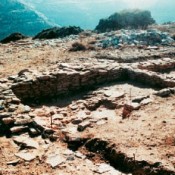The Idaion Andron is the most important cave of antiquity due to its relationship to myths concerning the birth and life of Zeus. It was discovered one hundred years ago and still stands as a challenge to archaeological study. Therefore, the new research that started in 1982 is equally important as the first excavation of 1885 that produced celebrated pieces of art. The significance of the recent excavation lies in the fact that through its finds the history of the Idaion Andron can for the first time be reconstructed from the earlier to the later phase of antiquity.
It can be proved by now that the famous cave was first used in the late Neolithic period and that it remained in use throughout the Bronze Age, both in the early and in the middle Minoan period. Α cult is verified in the late Minoan period, probably the cult of the Minoan annually born god of vegetation and growth, whose successor in the Mycenean era is Zeus in the form of the so-called “Κρητογενής» (= born in Crete) Zeus. This cult lasted for centuries and reached its apogee in the Geometric and early Archaic years as can be proved by a multitude of precious offerings. The finds of the last excavational phase, man-made objects or utensils, (imports in many cases from various areas of the eastern Mediterranean) are not only interesting for their contribution to the history of art but they are also significant for revealing the ritual of the cult which, at least in certain periods, appears exceptionaIIy dynamic.
The new exploration of the mountain of Ida (Psiloritis) was not limited only to the cave but it also covered the central volume of the mountain, where many ancient sites were identified. Α huge Minoan edifice was partly discovered on one of those sites called Zominthos. Furthermore, the exploration of the cave itself was not confined to historic and archaeolgical study, but expanded into many branches of physical science in spite of the innate difficulties and negative conditions of such a remote, mountainous place.



